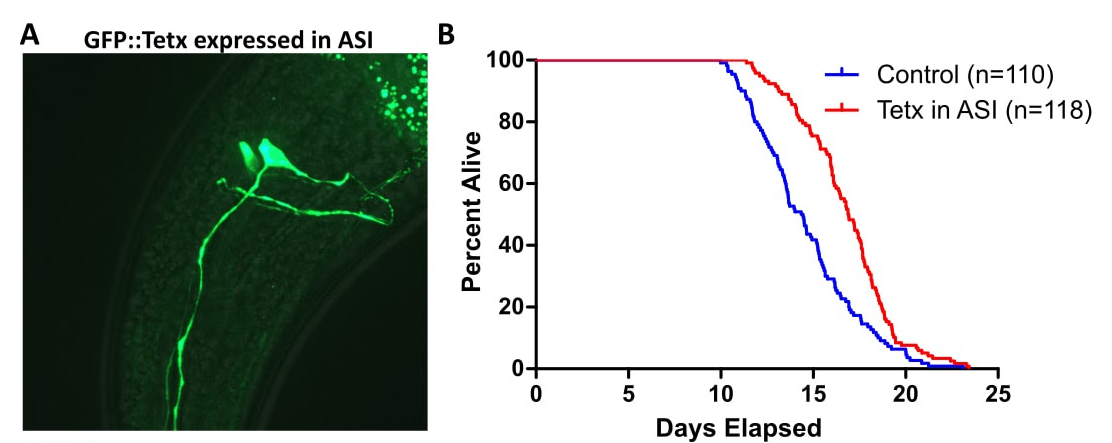Description
Disrupting the function of sensory neurons of C. elegans can increase their lifespan (Apeld and Kenyon 1999). This effect is not limited to large-scale disruption, as ablation of single pairs of neurons have been shown to modify lifespan (Alcedo and Kenyon 2004; Lee and Kenyon 2009; Liu and Cai 2013). We tested whether silencing the neuron pair ASI with the tetanus toxin light chain (Tetx), as opposed to ablating it, could increase lifespan. Tetanus toxin disrupts neurotransmission by blocking the release of both small clear-core vesicles and large dense-core vesicles, but should not affect communication via gap junctions (Schiavo et al. 1992; McMahon et al. 1992). We expressed GFP::Tetx using the ASI-specific promoter pgpa-4 (Figure Panel A) and conducted lifespan assays comparing animals with high fluorescence and undetectable fluorescence. Tetx in ASI extended lifespan in otherwise wild-type animals (Figure Panel B, Table 1, 14.9% average median lifespan increase across 5 replicates).
Table 1
| Experiment # | Strain | Median Lifespan | Sample Size | P (Tetx vs. Control) | Automated? |
| 1 | Tetx in ASI | 17 | 66 | 0.0125 | no |
| Control | 15 | 55 | |||
| 2 | Tetx in ASI | 16.9 | 118 | <0.0001 | yes |
| Control | 14.4 | 110 | |||
| 3 | Tetx in ASI | 15.9 | 141 | <0.0001 | yes |
| Control | 13.4 | 93 | |||
| 4 | Tetx in ASI | 16.3 | 156 | 0.0471 | yes |
| Control | 14.1 | 86 | |||
| 5 | Tetx in ASI | 23 | 98 | 0.0025 | no |
| Control | 21 | 68 |
Methods
Request a detailed protocolLifespan assays were conducted as previously described (Apfeld and Kenyon 1999) by hand with no FUDR, as well as utilizing automated lifespan machines (Stroustrup et al. 2013).
Reagents
Strains:
CF4126: muEx641[pPC30(pgpa-4::GFP::Tetx) + punc-122::RFP]
References
Funding
NIH R01 AG011816
Reviewed By
Joy AlcedoHistory
Received: May 24, 2018Accepted: June 1, 2018
Published: June 1, 2018
Copyright
© 2018 by the authors. This is an open-access article distributed under the terms of the Creative Commons Attribution 4.0 International (CC BY 4.0) License, which permits unrestricted use, distribution, and reproduction in any medium, provided the original author and source are credited.Citation
Chisnell, P; Kenyon, C (2018). Silencing the ASI gustatory neuron pair extends lifespan. microPublication Biology. 10.17912/ft9e-7e37.Download: RIS BibTeX




